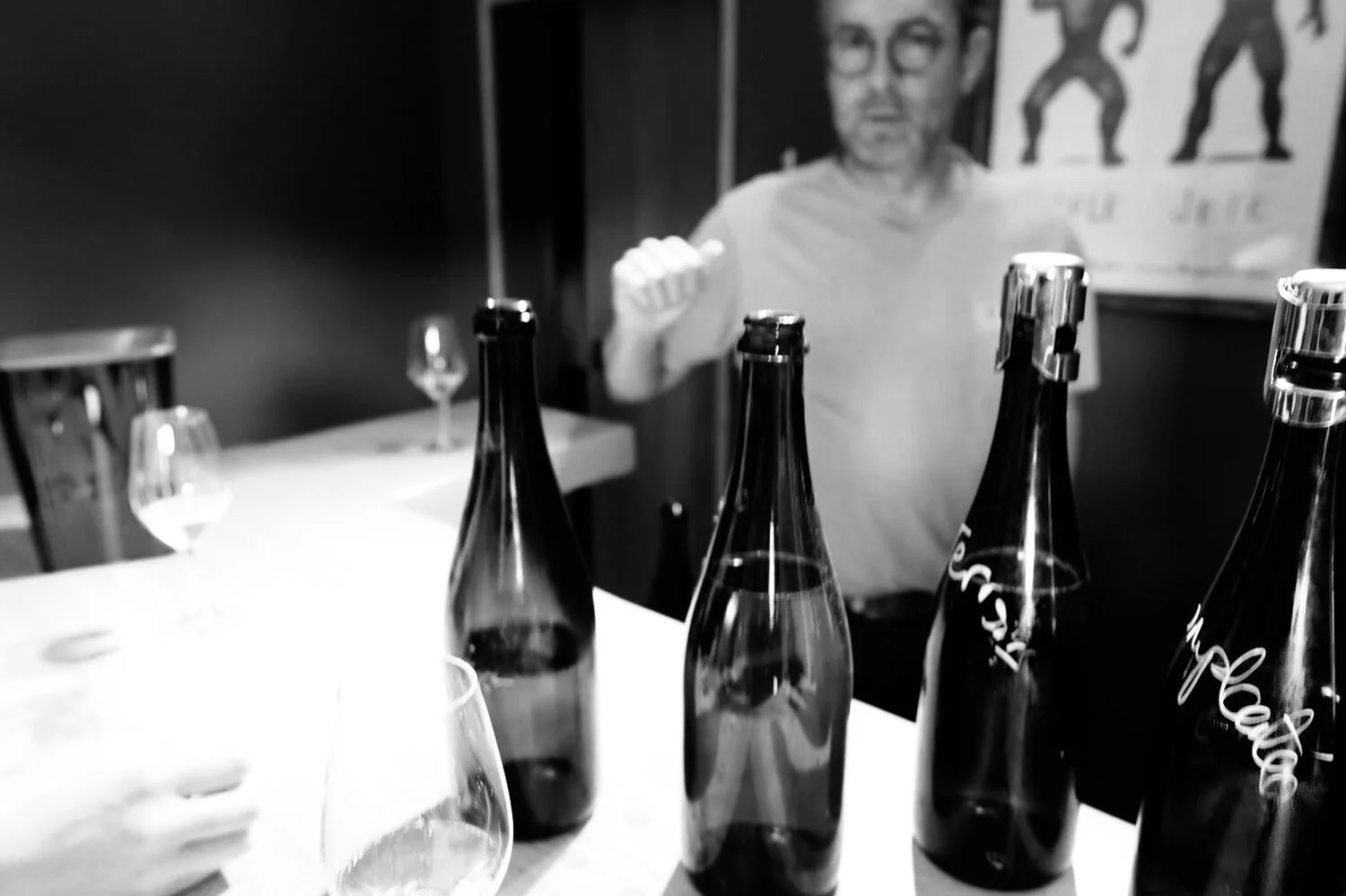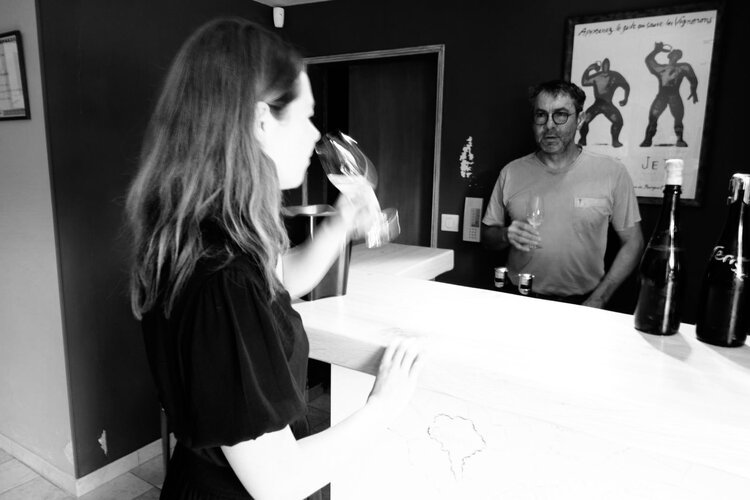A morning with Pascal Agrapart
I clearly remember my first natural champagne. It was at the end of 2014, in brasserie la Banque in Épernay . My table companion asked me if I’d ever had great champagne, and like any other normal person, I replied: “Don’t bother, I don’t like champagne." Fortunately, my refusal didn’t impress him much, so he ordered two coupes of 7 Crus by Pascal Agrapart. I took a sip, and, well, the rest is history. So imagine my excitement when 5,5 years later, the same Pascal Agrapart welcomed me to his home to answer my many questions.
Who is Pascal Agrapart?
The champagne house Agrapart dates back to the 19th century and was founded by Arthur Agrapart. The company has been growing its own grapes from the very beginning, making them a prime example of a Récoltant-Manipulant (= champagne houses that both grow grapes and make champagne). The Agrapart domaine covers 10 acres in grand-cru villages Avize, Oiry, Oger and Cramant, and their territory is known for its high quality vineyards, with an average vine age of over 40 (which is old!). Today, Pascal Agrapart is at the helm of the champagne house, and he’s gradually transferring the company to his son Ambroise. Both of them hold on to a 100% natural production process and limit additives to a minimum. This includes sugar, making all Agrapart champagne very low dosage and au naturel (hence, my favourite). They make 7 in total:
7 crus
Complantée
Terroirs
Minéral
Avizoise
Vénus
Expérience
Scared of the dog, starstruck by the man
We arrived in Avize on a Saturday morning, but it was already burning hot. I rang the doorbell of a large, massive porch, which was answered by the bark of a dog. As his big paws were all I could see, I decided to wait until someone came to both let us in and calm down the potentially dangerous animal. After a few minutes of fear and passiveness, the porch was opened by Pascal himself. Starstruck as I was, I forgot all my French, except for a very messy “Bonjour”. The dog turned out to be everything but dangerous, but that didn't really calm me down. What to say to this man? Which questions to ask so that he wouldn't consider his time wasted? As we followed Pascal into the house, I desperately tried to remember my best questions, but I got nothing. All I remembered was that I wanted to meet the man that made me fall in love with champagne. A rather scanty basis for an interview.
When tasting champagne- don’t swallow
Fortunately, Pascal had done this kind of visits before. He walked to a counter, disappeared and turned up holding three glasses and a bottle. Thank God, we were going to taste champagne and he was going to join us. With a faltering voice, I told him about the scene in La Banque in 2014, which he did seem to enjoy. He opened the first bottle and filled our glasses. “C’est quel champagne celui-ci?” I asked. “7 crus” Pascal replied. So we were starting off with the one! I took a sip, let the wine swirl through my mouth and swallowed. I looked at Peter and Pascal, who had both used the spit bucket. Oh right... I prayed that Pascal didn’t notice my naivety and focused on my glass. Although I liked it, 7 crus didn’t enchant me like it had done in 2014. Pascal explained that 7 crus was the most approachable champagne he produced, and that it was to be enjoyed by many people on many occasions. This could only mean one thing: over these last years, my taste buds had become spoiled and I was ready for the real deal.
6 grape varieties- 1 very cherry champagne
And the real deal came. Out of the seven champagnes we tasted (and spit in the spit bucket like adults), the second hit me like lightning. Complantée was introduced by Pascal as an extra brut champagne, made out of usual suspects Chardonnay, Pinot Noir and Pinot Meunier, but also with the older varieties Arbane, Petit Meslier and Pinot Blanc. Although they’re all champagne grape varieties, the last three aren’t commonly used, which (I believe) makes them fascinating. All grapes in Complantée came from Avize, and together, they formed an intensive flavour ballet with hints of cherry, but without being too sweet. For the second time that day, I was starstruck, and the look on our faces made Pascal smile. He had hit the jackpot (or had we?) and there were still five champagnes to go. Out of those five, I found Vénus and Avizoise were also exceptionally good. Slowly but surely, I relaxed, and more and more questions came to mind.
"Sans l’homme, le champagne va se détruire”
-Pascal Agrapart
A pinch of salt
Pascal ended the tasting round with Expérience, the only champagne to date that’s made out of grapes exclusively. “No one ever tried to leave out all the additives” Pascal told us, “so I started experimenting.” Already after their first try, Pascal realised they were onto something. “We used the grape juice as liqueur de tirage, and we only used a very low amount of sulphites,” he continued. When asked why he needed the sulphites anyway, he smiled and said: “Sans l’homme, le Champagne va se détruire” (without human intervention, champagne will destroy itself). He explained: “Think of sulphites as salt or sugar. When you eat too much of it, you’re going to poison yourself. When you add a pinch, it lets all flavours rise above themselves.” I quite enjoyed this take on the champagne production process, in which both the man, the grape variety and the soil play a part. No long story about how one should let nature take its course, but a down to earth approach that’s all about craftsmanship and experimentation. After all, champagne doesn’t grow on trees- it’s made by human hands, and it really matters which pair.
Local tips to go
Having tasted all 7 Agrapart champagnes, we got a tour of the domaine. It was small, yet it had everything they needed. Pascal and Ambroise use both tanks and oak casks, and make sure the casks are always full. This way, the champagne travels the domaine, one corner to another. When we came back in the tasting room, Peter and I started our usual dance in which we try to take home one or two bottles, and then end up with seven or eight (I say “we” but it’s mainly him). We agreed on two Complantées (our favourite), an Expérience (to quote Peter: “Because it’s very cool”) and a magnum bottle of Terroirs (“Because it’s a magnum”). Before we left, we asked Pascal about his favourite spots in the champagne region. We’re so addicted to the hotspots we know, that we could really use some advice from a local hero. Pascal shouted a few words to the living room, where a woman’s voice replied with “Racine in Reims and Cookin’ in Épernay”. Pascal himself added La Gare in Mesnil-Sur-Oger and Les Crayeres in Reims. All great places, so we found out, that would really fit in our French itinerary.
We left the domaine, petted the not-so-scary dog, and said our goodbyes. I had a hard time forgiving myself for my rocky start, until I realised I got what I came for. I had tasted all seven Agrapart champagnes, I had found a favourite, I had talked to the creator of the first champagne I ever loved and we had a trunk filled with bottles.
How different from 2014, when I thought things couldn’t get any better.
Get ‘Champagne - the Ultimate Guide’
Liked this article? Then you’re going to love my 45-pages guide about champagne. Get it here!

